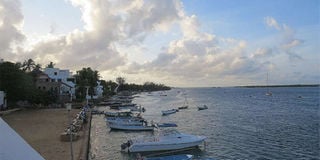A glimpse of Shela’s history

View of Manda Channal from a room in Shella Baharini, Lamu. PHOTO| RUPI MANGAT
What you need to know:
- “There were only makuti-thatched houses here when I was a boy,” says Tawfiq Ahmed Ali of Shella Bahari Guest House on the seafront.
- The dunes are Lamu’s life-lung. Soaking in the rainwater, they are a natural reservoir and a wind-break, protecting the island from the ravages of the sea like the tsunami in 2004.
- Back at Shela Bahari, we close the door behind us. The chef brings in a fish cooked in coconut and spices and we dine on our balcony as the dhows move silently through the night.
I’m reading ‘Quest for the Past’, an interesting historical guide to the Lamu archipelago, by Chrysee MacCasler Perry Martin and Esmond Bradley Martin, and published in 1969. The sultan of Pate raided Kitau on Manda island in the mid-14th century and the people there fled to Lamu town as refugees. 200 years later, they asked the Sheikh of Lamu if they could build their own town, Shela. He agreed, on condition that no stone was used for building.
“There were only makuti-thatched houses here when I was a boy,” says Tawfiq Ahmed Ali of Shella Bahari Guest House on the seafront.
“Even this house was just one storey with a makuti roof. We built the rest later when tourism picked up.”
Shela was Lamu town’s poorer cousin. According to the book, Shela had a brief period of prosperity in the 19th century when fine stone houses with ornately decorative walls were built by the Arabs who owned large plantations that slaves worked on. But when the slaves began to leave by the 1890s, Shela slumbered again. By the 1960s, there were fewer than 250 people and of the 100 fine houses, only 40 were occupied. Most youngsters had left.

Streetview of Shela. PHOTO| RUPI MANGAT
Enjoying a hearty breakfast by the ocean-front, the water’s animated with a shoal of flying fish. Wooden dhows and speedboats ferry people between Lamu town, Manda and Shela. Afterwards, we stroll around the now-thriving holiday town, through narrow alleys bursting with pops bougainvillea and gorgeous Swahili-influenced holiday homes.
Famau Shukri of Lamu Marine Conservation Trust, a hard-core turtle man, meets us by the dunes of Shela. “Shela is the mother beach of turtle’s nests,” he says proudly. “In 2015, we had 20 nests, a record number since we began keeping records in 1992.”
Having been on earth longer than the dinosaur, modern challenges threatens the gentle mariner: fishers’ nests, plastic, big ships and hatchlings heading towards bright lights instead of the ocean. It’s estimated that only one in every 1,000 survives.

1969 booklet - Quest for the Past - a historical guide to Lamu Archipelago by Chrysee MacCasler Perry Martin and Esmond Bradley. PHOTO| RUPI MANGAT
Sailing across from Manda island to Lamu island, a Green turtle surfaces for a split second to breathe and dive down again to nibble on the coral gardens below.
Famau escorts us up the dunes that, until 20 years ago, were just sand mountains. We walk past a grave yard where an important elder is buried from a few centuries ago, his grave under a hut. A flight of steps takes us to the top of the nearest dune, giving an eagle-eye view of Shela and the ocean.

From the dunes of Shela looking across the Manda channal to Manda. PHOTO| RUPI MANGAT
We pass more stunning homes of the rich on the dunes – and then the most amazing view of dune after dune after dune for 12 kilometres. From this vantage point – a towering 200 feet above sea-level – the open ocean stretches to the horizon. Then the mosaic of the mangrove lined channels and Manda Island with its gorgeous beach.
The dunes are Lamu’s life-lung. Soaking in the rainwater, they are a natural reservoir and a wind-break, protecting the island from the ravages of the sea like the tsunami in 2004.
Doum palms and thorn trees grow scattered on the sand mountains and we run down to the beach, walking along its shores back to what used to be a simple fishing village.
Shela’s famous historical event is the Battle of Shela where the Sultan of Pate decided to throw the gauntlet at the more powerful Lamu sultan’s feet. In 1812, his army sailed in from Pate and fought the battle forgetting about the tide, which left them stranded on the beach to be slaughtered by the enemy. It’s said that for years, the Shela beach was littered with the sun-bleached bones of the stranded army.

The 1829 Friday mosque today in Shela, Lamu. PHOTO| RUPI MANGAT
We reach a mosque with its tall, white minaret gleaming in the sun. Built in 1829, it’s a landmark surrounded by the new.
Back at Shela Bahari, we close the door behind us. The chef brings in a fish cooked in coconut and spices and we dine on our balcony as the dhows move silently through the night.
www.rupitheafricantrotter.wordpress.com




